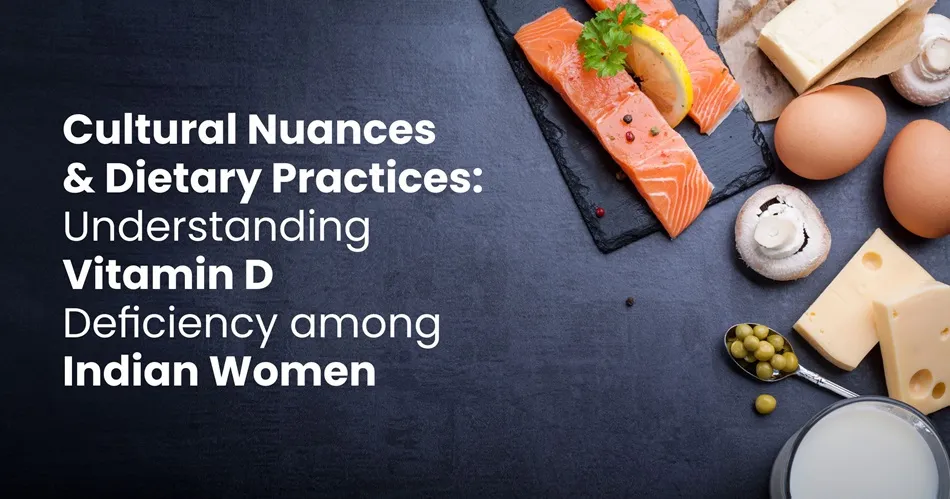Cultural Nuances and Dietary Practices: Understanding Vitamin D Deficiency among Indian Women
Jan 09, 2024

In India, vitamin D deficiency has become a significant public health issue, with women bearing the brunt of the consequences. Recent research indicates that more than 90% of Indian women do not consume enough vitamin D through sunlight exposure and diet. This development is concerning in light of the vital function that vitamin D performs in maintaining healthy bones and overall well-being.
Decreasing vitamin D levels, clinically defined as less than 20 ng/ml of the vitamin in blood serum, negatively impact Indian women’s health, causing issues with brittle bones, impaired muscle strength, frequent infections, chronic tiredness, and low immunity.
Causes of Vitamin D Deficiency in Indian Women
Vitamin D insufficiency is a worldwide health problem, particularly in India. Several reasons cause vitamin D deficiency in Indian women. Here are a few common causes:
Lack of Adequate Sun Exposure
The prevalence of conservative attire that envelops most of the body is particularly pronounced among women in Northern India.
Even when outdoors modest clothes are frequently worn. This reduces the amount of sunlight that reaches the epidermis, which is critical for the synthesis of vitamin D. The production of vitamin D by the epidermis experiences a substantial decline in winter, even in regions of India that receive ample sunlight.
Traditional Dietary Practices
Some traditional dietary practices also contribute to vitamin D deficiency in Indian women.
- Vegetarian and lactovegetarian diets in India do not typically prioritise vitamin D rich foods such as fatty salmon, eggs, or mushrooms.
- Few Indian meals feature fatty fish or seafood, the best dietary vitamin D sources Social limitations on seafood intake, high prices, low affordability of fish oil capsules, and ignorance of their benefits hinder sufficient consumption.
- Pulses and lentils, which constitute the fundamental components of Indian cuisines, are notably deficient in vitamin D.
- Compared to whole milk, even milk is typically consumed in skimmed or toned varieties, which are vitamin D deficient.
- The absence of supplementary foods when consuming staples such as rice and roti also impairs the assimilation of vitamin D.
Indoor Lifestyle
Rural women often work long hours indoors due to the gender-based division of labour. Urban middle-class and affluent women also tend to stay and work mostly indoors. This eventually leads to lower exposure to sunlight and vitamin D production.
Urban Lifestyles
Long work commutes and indoor jobs keep urban Indian ladies off sunlight for hours daily. City pollution and smog also block UV rays even when spending time outside. Working night shifts disrupt circadian cycles, too, impacting melatonin, which regulates vitamin D activation. Less leisure time in the sun equals less vitamin D reserves.
Genetic Factors
Research indicates that genes significantly influence the metabolism and action of vitamin D. Many Indians possess genetic variants that hinder the activation or utilisation of vitamin D within the body. Due to this innate characteristic, they are predisposed to deficiencies even with sufficient nutrition or radiation exposure.
Risk Factors for Vitamin D Deficiency
It is crucial to identify the risk factors to ascertain individuals who require additional monitoring and supplementation.
Levels of Vitamin D in Women
Here is a short table indicating the abnormal and optimal vitamin D levels in women:
in women:
|
Vitamin D Level |
Description |
|
30 ng/mL or higher |
Normal |
|
20 - 29 ng/mL |
Adequate vitamin D levels, but could be slightly improved |
|
12 - 19 ng/mL |
Below optimal for bone and overall health |
|
Below 12 ng/mL |
Deficiency, which requires increased intake of vitamin D |
Pregnancy and Lactation
The requirement for vitamin D goes up significantly during pregnancy and breastfeeding to support critical fetal bone development and calcium homeostasis.
- Unfortunately, traditional Indian diets composed mainly of cereals and lacking vitamin D-fortified foods often cannot meet this elevated demand during gestation and lactation.
- Social taboos also limit pregnant women's mobility and sun exposure in some communities.
- Indian mothers tend to have low vitamin D reserves even before conception.
Elderly Women
Age-related reductions in sun exposure, dietary consumption, and epidermis synthesis contribute to the vulnerability of postmenopausal women. Deficiency in vitamin D is prevalent among individuals aged 60 and older.
Obese/overweight Women
Obese and overweight women often have lower blood levels of vitamin D. This is because vitamin D is a fat-soluble vitamin, which means it is stored in body fat. The excess body fat in obese women can trap vitamin D, making less of it available for the body to use. The trapped vitamin D has a reduced ability to convert into active form. As a result, obese women have more difficulty utilising vitamin D properly and maintaining adequate blood levels. The more body fat, the less usable vitamin D, leading to higher deficiency risks.
Malabsorption Issues
Lactose intolerance, celiac disease, and inflammatory bowel disease are prevalent conditions in India that impede the absorption of nutrients from food. This further diminishes the vitamin D levels of women with inadequate dietary intake.
When to See a Doctor for Vitamin D Deficiency
- Although mild vitamin D deficiency may not cause noticeable symptoms, anyone who suspects they have low levels should immediately see a doctor.
- Symptoms such as prolonged muscle or bone pain, weariness, melancholy, or mood fluctuations should be evaluated by a doctor, especially if they are unexplained.
- The risks are more significant during pregnancy; testing is advised between weeks 24 and 28.
- High-risk groups, such as pregnant or nursing women, the elderly, and those with malabsorption problems, should regularly check their vitamin D levels as a doctor prescribes.
- Individuals with osteoporosis, rheumatoid arthritis, TB, multiple sclerosis, or other autoimmune illnesses linked to deficiency should be tested.
- Vitamin D insufficiency in mothers necessitates supplementation and close monitoring of newborns.
Intervention and early detection can reverse deficits and reduce consequences. Thus, it is best to seek the advice of a medical practitioner for the best course of treatment.
Final Word
Maintaining optimal vitamin D levels is critical for overall health and well-being. While insufficiency is often overlooked, the potential long-term implications on health cannot be overlooked. If the symptoms are present, they should be regarded seriously, and professional medical help should be sought immediately.
In this sense, Apollo Diagnostics is a trustworthy partner in your quest for improved health. We provide comprehensive vitamin D testing and individualised advice from qualified healthcare professionals using cutting-edge diagnostic services. Don't wait until your symptoms worsen; take charge of your health now.
Frequently Asked Questions:
Who needs Vitamin D supplements?
Supplementary vitamin D is advised for individuals whose diets are deficient in vitamin D-rich substances or who do not receive sufficient sunlight. Patients with malabsorption issues, pregnant or lactating women, elderly individuals over the age of 60, individuals with dark complexion, or those who cover their bodies for cultural or religious reasons are included in this category.
What are some dietary sources of Vitamin D?
Fatty seafood such as mackerel, tuna, and salmon are among the finest dietary sources of vitamin D. Vitamin D is also found in egg yolks. Mushrooms exposed to ultraviolet light and plant milks fortified with vitamin D can assist vegetarians in meeting their daily requirements. In India, nutritious dairy products include paneer, curd, and milk fortified with vitamin D.
What are the health impacts of Vitamin D deficiency?
A chronic deficiency in vitamin D can increase the risk of osteoporosis, fractures, musculoskeletal discomfort, and bone deterioration. Additionally, it is associated with specific types of malignancies, cardiovascular ailments, depressive symptoms, autoimmune disorders, infectious diseases, and pregnancy complications such as preeclampsia. Deficiency in children results in rickets, characterised by bowed legs and stunted growth.
Related Blog Post
Blog Categories
- Child Health
- Mens Health
- Women's Health
- Mental Health
- Health Myths & Facts
- Fitness
- Nutrition/Recipes
- Remedies
- Weight Management
- Stress Management
- Health Supplements
- Addiction Management
- Disease Management
- Allergy
- Anemia
- Arthritis
- Asthma
- Autoimmune Diseases
- Blood Pressure
- Cancer
- Deficiencies
- Dengue/Malaria/Chikungunya
- Diabetes
- Eye Problems
- Heart Diseases
- Hepatitis
- HIV/AIDS/STD
- Hormonal Imbalance
- Infection/Flu/Viral
- Kidney
- Liver
- Menstrual Problems
- Pregnancy
- Skin & Hair Problems
- Stomach Ailments
- Thyroid
- Others
- Health Checkups
- Diagnostics/Pathology
- Lifestyle & Wellness
- Covid
- Medical Tests
- Cholesterol
- Health Tips
- Parent Care/Old Age
- Lungs
- Food Intolerance








